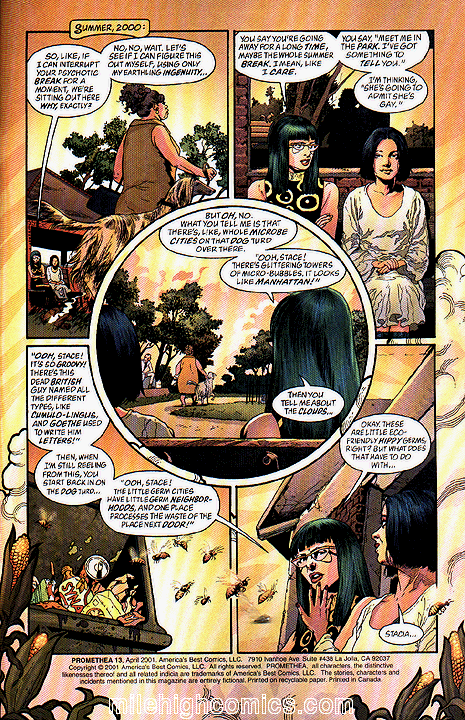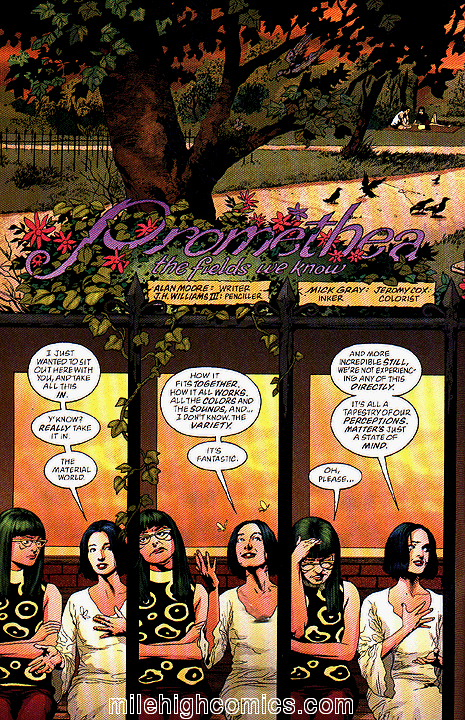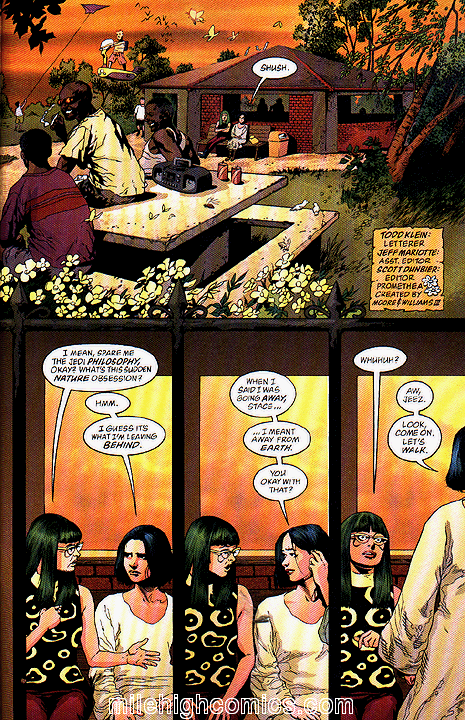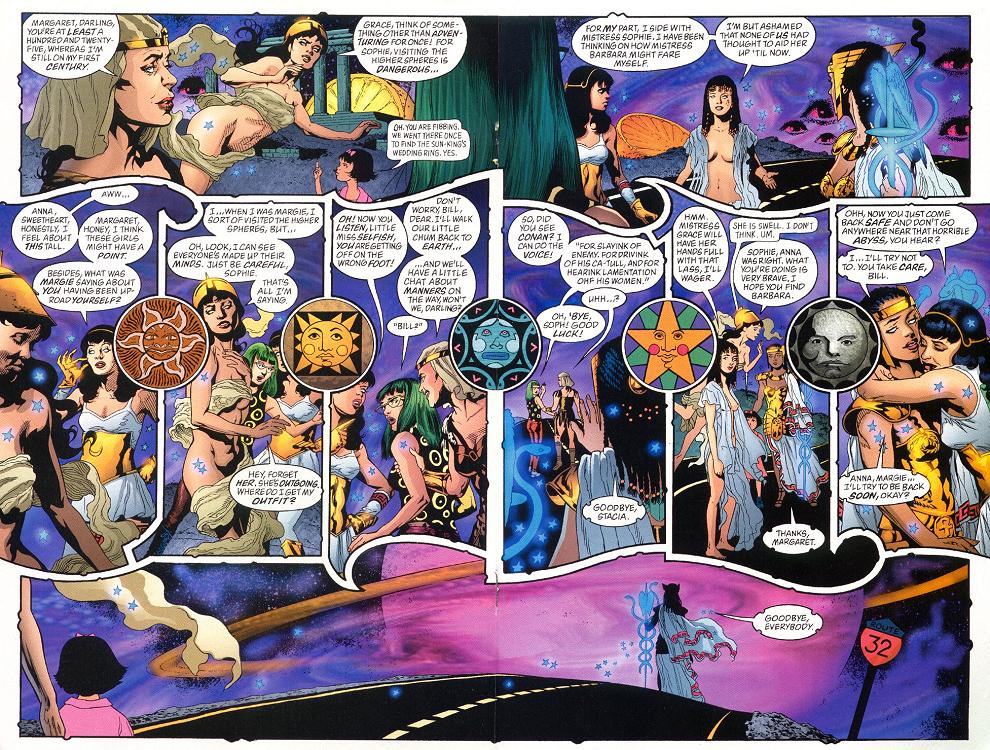
TITLE:
The Fields We Know is an allusion to a short story collection by Lord Dunsany entitled Beyond the Fields We Know
SYNOPSIS
Summer 2000: Sophie is determined to go off in search of Barbara. She sets up Stacia to take over the role of Promethea in her absence as she expect to be gone for quite a while. Transforming into Promethea she explains to Stacia a bit about the Kabbalah and manages to convince the other 4 previous Prometheas to let Stacia take over the role while she's gone. Stacia will be merging with Grace Brannagh as the substitute Promethea. Promethea(6) talks to the Universe and an allegorical figure from the 16th century before stepping onto a boat steered by an old man who turns out to be Charon and tells her she's dead.
QUOTES
"You say, 'Meet me in the park. I've got something to tell you. I'm thinking she's going to admit she's gay" - Stacia, pg. 1
"It’s all a tapestry of our perceptions. Matter’s just a state of mind.” – Sophie
“Oh please. I mean, spare me the Jedi philosophy, okay?” – Stacia, pg. 2
"When I said I was going away, Stace...I meant from earth" - Sophie, pg 3
“There’s the planets, Mercury, Jupiter, Saturn, whatever. Big physical balls of gas and rock, hanging in space. Then there’s what those planets mean…”- Sophie
“What, like cheap real estate?” – Stacia, pg 4
“Magic…it’s an attempt to map existence, both physical and non-physical”- Sophie, pg 4
“Stacia Vanderveer, you are a rude, conceited, selfish $&&-hole, but you are my best friend” – Sophie, pg 5
“…this is still earth…it’s just that this is the upstairs part” – Promethea(6), pg 6
“…even the earthly material plane has graded levels. They range from the dense blackness of the underworld up to this highest, most ethereal and symbolic level of awareness” – Promethea(6), pg. 8
"Hey, what happened to those bratty tourist kids I saw earlier?" - Stacia
"They're still there. You're just seeing them now as whey they symbolize. It's the four princesses of the tarot pack. They're attributed to this earthly sphere. It's like each of the four elements in their earthly manifestation" - Promethea(6), pgs 8-9
“It’s as complicated as one needs it to be. It’s got big general measurements, and fine gradations, like any system. If you like, it can be as simple as a child’s game” – Promethea(6), pg 9
“What’s this? Hopscotch for the color blind?”- Stacia, pg 8
“…this is like a map, or maybe a circuit board. It’s the structure of things, whether that’s the universe or each individual human soul” – Promethea(6), pg 8
“It’s also the road atlas for heaven” – Promethea, pg 9
"What's going on?" - Promethea (3)
"Me Grace. I'm going on…after Barbara - Promethea (6), pg 12
"Honey, the higher you climb the tree the bigger the chance you don't come back" - Promethea(?), pg 14
"…humanity desperately needs a Promethea right not, to lead them up from the dark of matter into the blaze of spirit" – Promethea(6), pg 15
“Darling, are you trying to upset us? As if just any little schoolgirl could be Promethea…” – Promethea(?)
“Hey, like I’m desperate to be on some cosmic chorus line with Xena’s mom here!” – Stacia, pg 15
“Imagine it, Grace. Being able to adventure in the physical world again! And you, Stacia. Imagine being a famous science-heroine.” – Promethea(6)
“Are you insane? Me, as some sort of celebrity icon? That’d be…actually, thinking about it, that’d be sort of cool” – Stacia, pg 15
"Margaret, Darling, You're at least a hundred and twenty-five, whereas, I'm still on my first century" - Promethea(?), pg 16
“Our dance is in your eyes…and all the ssstarsss are inssside your mind” – Universe (snake), pg 20
“Didn’t I just pass you, down the road?” – Promethea(6)
“Hum? Oh, no. that must have been somebody else. We symbolic old men tend to look very much alike” – Charon, pg 23
“As for introductions…I’m Charon…and you’re dead” – Charon, pgs 23-24
NOTES & ANNOTATIONS:
Kabbalah

Malkuth
Reality Creator Workbook Series

Page 1 Panel 1: The dog turd which is referred to in Panel 3 can be seen here.
Panel 4:
The dead British guy being referred to is Luke Howard (1773-1864). Here are three different web pages about him.
How are clouds named and who named them
The Man who named the Clouds
The Godfather of the Clouds
Cumulo-lingus combines Cumulonimbus (which is a type of cloud) and cunnilingus (which is a type of sex).
And Goethe used to write him letters
Here's a poem about Howard by Goethe in the original German sent to me by TL:
Goethe's poem on Howard is called "Atmosphäre/ Howard's Ehrengedächtnis" (in honour of Mr. Howard). He wrote it between 1817 and 1821, it was published first in 1822.
Goethe inserted the poem in the section "God and world" of his collected poems (1827). Here's the beginning of the original text:
Howards Ehrengedächtnis
Wenn Gottheit Camarupa, hoch und hehr,
Durch Lüfte schwankend wandelt leicht und schwer,
Des Schleiers Falten sammelt, sie zerstreut,
Am Wechsel der Gestalten sich erfreut,
Jetzt starr sich hält, dann schwindet wie ein Traum,
Da staunen wir und traun dem Auge kaum;
Nun regt sich kühn des eignen Bildens Kraft,
Die Unbestimmtes zu Bestimmtem schafft;
Da droht ein Leu, dort wogt ein Elefant,
Kameles Hals, zum Drachen umgewandt,
Ein Heer zieht an, doch triumphiert es nicht,
Da es die Macht am steilen Felsen bricht;
Der treuste Wolkenbote selbst zerstiebt,
Eh er die Fern erreicht, wohin man liebt.
Er aber, Howard, gibt mit reinem Sinn
Uns neuer Lehre herrlichsten Gewinn.
Was sich nicht halten, nicht erreichen läßt,
Er faßt es an, er hält zuerst es fest;
Bestimmt das Unbestimmte, schränkt es ein,
Benennt es treffend! - Sei die Ehre dein! -
Wie Streife steigt, sich ballt, zerflattert, fällt,
Erinnre dankbar deiner sich die Welt.
[Goethe: Gedichte (Ausgabe letzter Hand. 1827), S. 746. Digitale Bibliothek Band 1: Deutsche Literatur, S. 19998 (vgl. Goethe-BA Bd. 1, S. 551-552)]


Pages 2-3 top panel:
Note the 3 black men in the foreground are smoking a joint. The hovercraft like scooter descending, someone flying a kite, etc.
Pages 4-5: Nice plant splitting up the two pages. The circles or spheres on it are colored to represent the Kabbalah sephiroth.
Page 4 Panel 2: the man with his girlfriend feeding him some sort of sausage will reappear in a more memorable guise on pg. 7 and we will see them again much later in Issue #23.
Panel 3: the four girls will also reappear in a more recognizable guise on pg. 7.
Panel 5: the image of the cat jumping to catch a bird is very similar to one in Miracleman Book Two page 107 except that in Miracleman the cat actually manages to catch the bird.
Page 6 bottom panel:
The woman feeding the birds has taken on the body of the cat who was trying to catch them and become a sphinx.
Page 7 right hand panel: I'm not sure who the four armed girl looking down on the scene from above is. Probably some Hindu deity though I'm not sure which one. The four girls have been transformed into Indian women each holding one of the four trumps of the tarot deck: Pentacles, Wands, Swords and Cups. The man is now being fed an apple by the woman and being naked the couple seem to represent Adam and Eve.
Not sure who the Egyptian statue(?) looking at the fire in the vase is supposed to represent.
Claire Jordan thinks that
it's an actual live (astral) Egyptian man. And he's not looking at the fire in the vase or urn or whatever it is - if you look at its base you'll see the vase/urn is right in the foreground of the picture, whereas the Egyptian is a long way behind it
Pages 8-9 bottom panel:


Nice representation of the kabbalah drawn on the ground.
The color of the sephiroths are:

Page 10 Panel 1:
Planetary symbol for earth
The four colors are:

Pages 16-17: Note the 5 different sun logos splitting up the panels. Each one represents a different Promethea.
Page 16 Panel 1: Little Margie is referring to events that occured in the story Little Margie in Mystic Magic Land which is not part of Alan Moore's scripted Promethea cannon.
Page 17 panel 2: Does anyone know if the lines Stacia quotes are from Conan the Barbarian (1982) or Conan the Destroyer (1984)? From the way she pronounces them they must be spoken by Arnold Schwarzenegger. Perhaps she just made them up.
Pages 18-19: Nice huge two page spread. The figures I can make out are:
The Universe represented by the Woman & snake
Man pouring water(Aquarius?)…flying saucers…winged smiley faced birds turning into scissors…lion…folded paper…fairies…boot with spider legs…living bricks...possible anticipation of Daath and several planets and the crescent moon. Also the orange/lemon looking like the sun on the horizon.
Page 20 Panel 1: Note the dice insects at Promethea's feet.
Page 21 Panel 2:
"We love you of course we do" from the Rolling Stones song We Love You.
In February 1967, Mick and Keith are arrested when Keith's Redlands home is raided by the police. Thus starts the run of high-profile court appearances that divide the nation's generations and are widely believed to be part of some greater conspiracy to silence the unbelievably powerful Stones. But despite all the charges hurled against Jagger, Richards and Jones, no Stone went to jail for any extended period.
In August, the hastily assembled "We Love You" single is released to thank the public for their support during the Jagger/Richards trials.
from this page
Page 22: panel 2 "I'm just an allegorical figure from
a sixteenth century engraving".
Probably this one
